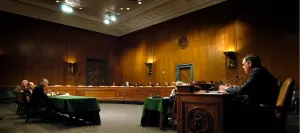The Briefing: Biden finally filling a long-vacant position.
- A nominee for US Ambassador to Ukraine
- Joe Biden is planning to nominate Bridget Brink
- She's a career diplomat currently serving as Ambassador to Slovakia
- She'll be replacing interim chargée d'affaires Kristina Kvien
- There hasn't been an official Ambassador to Ukraine since 2019
- A broader trend of slow confirmations
- 41%: Senate-confirmable positions that Biden filled in 2021
- 57%: Trump in 2017
- 69%: Obama in 2009
- 75%: Bush in 2001
The Big Question: What, if anything, should we do about this?
There are about 1,200 presidential appointments which are confirmed by the Senate. These include cabinet secretaries, assistant and deputy secretaries, and heads of smaller federal agencies. They make up just a small amount of the overall federal workforce, and there are about 2,800 other presidential appointees who don’t require Senate confirmation. But so-called “Senate-confirmable” posts make up the highest ranks of the federal bureaucracy, and if this is at all starting to sound like inside-baseball-type nonsense, just hold on.
The press has actually spent a solid amount of time covering the executive branch’s struggles to fill key jobs. The Washington Post and the Partnership for Public Service have collaborated on a “Political Appointee Tracker” that charts the number of Senate-confirmed posts: filled, waiting on confirmation, or waiting on nomination. There was also fairly extensive coverage of the holds Senators Ted Cruz and Josh Hawley placed on a number of ambassadorial appointments late last year.
When you put it all together, there’s no doubt that the major slow-down in nominations and confirmations over the past two decades is newsworthy. It’s surely one symptom of the nation’s spiraling partisan polarization. The party out of power, left with few tools to stymie the majority party’s agenda, throws up every conceivable parliamentary roadblock to make life difficult for the occupant of the White House. It’s certainly a bipartisan phenomenon—Democrats played precisely the same game with Donald Trump’s nominees that Cruz and Hawley are with Biden’s.
It might seem that an administration chugging along without filling some of its most important posts would find itself struggling to govern effectively. In a period of high inflation, a war in Europe that increasingly looks like it will last for a long time, it seems, well, bad that the capacity of the federal government to do its job could be constrained by an inability to get political appointees confirmed.
Indeed, the Partnership for Public service has recommended that the government strip many seats either of Senate confirmation or even presidential appointment entirely as features.
But is that the answer?
The Theory: The rise of “interim” appointments.
To get a better sense, we need to dig a little deeper into the actual operations of the modern day executive branch. In an article published last year, the political scientist Christina M. Kinane did just that, examining how the President and the Senate navigate the increasingly contentious process of nomination and confirmation.
Her argument is that Senate-confirmable positions may be vacant but not empty. Presidents often fill posts with interim appointments, like the embassy position in Ukraine between 2019 and now. Indeed, those “interim” appointments are sometimes only nominally so—the president appoints someone unilaterally to fill the post on an interim basis with no real intention of formally nominating someone else and seeing them confirmed.
This is especially true when the sitting president values the post in question—meaning he wants its occupant to pursue some policy agenda—and when he expects the Senate to oppose that agenda. Under those conditions, we should probably expect the government to function about as well as it would if someone were nominated and confirmed. All those vacancies that the press is tracking might be missing a big part of the story, with significant implications.
At the same time, it’s also important to note that there are conditions under which the president is likely to leave a post empty. If the post isn’t much of a priority, but he still doesn’t see eye to eye with the Senate on its direction, he might just leave it alone. And that very plausibly could have consequences, if a crisis strikes and there’s no one in charge.
The Takeaway: Don’t expect a fix.
What this suggests is that we might want to revise the theory—if only partially—that the increasingly slow confirmation process for appointees is hindering the functioning of government. Presidents appoint qualified individuals on an “interim”-ish basis to carry out the functions of government, and it works…more or less.
But as Kinane notes, when COVID struck, the Trump administration had—after three years in office—still failed to appoint a head of the Occupational Safety and Health Administration (OSHA). Without an OSHA head, the agency failed to formulate rules to protect workers during the early stage of the pandemic.
Overall, while posts like cabinet positions sensibly require confirmation, many others hardly need it. Trimming the number of positions requiring confirmation could help prevent abuse of power by regularizing a currently murky workaround, and it could give the Senate valuable time to focus on legislation instead of dragged-out confirmation hearings and votes.
Unfortunately, neither party has any particular incentive when it’s out of power to give up parliamentary roadblocks that prevent a president from filling out his or her administration. The Senate will keep dragging out nominations, and the president will keep making interim appointments. It’s just one of those things for which there’s a remarkably easy fix but—in our ever-deepening quagmire of political polarization and partisan parliamentary warfare—is unlikely to find the necessary political support anytime soon.
Subscribe to Spectacles

Comments
Join the conversation